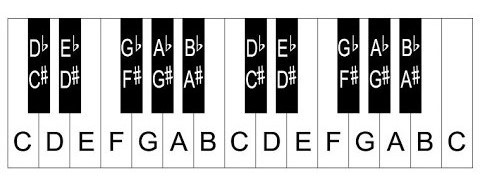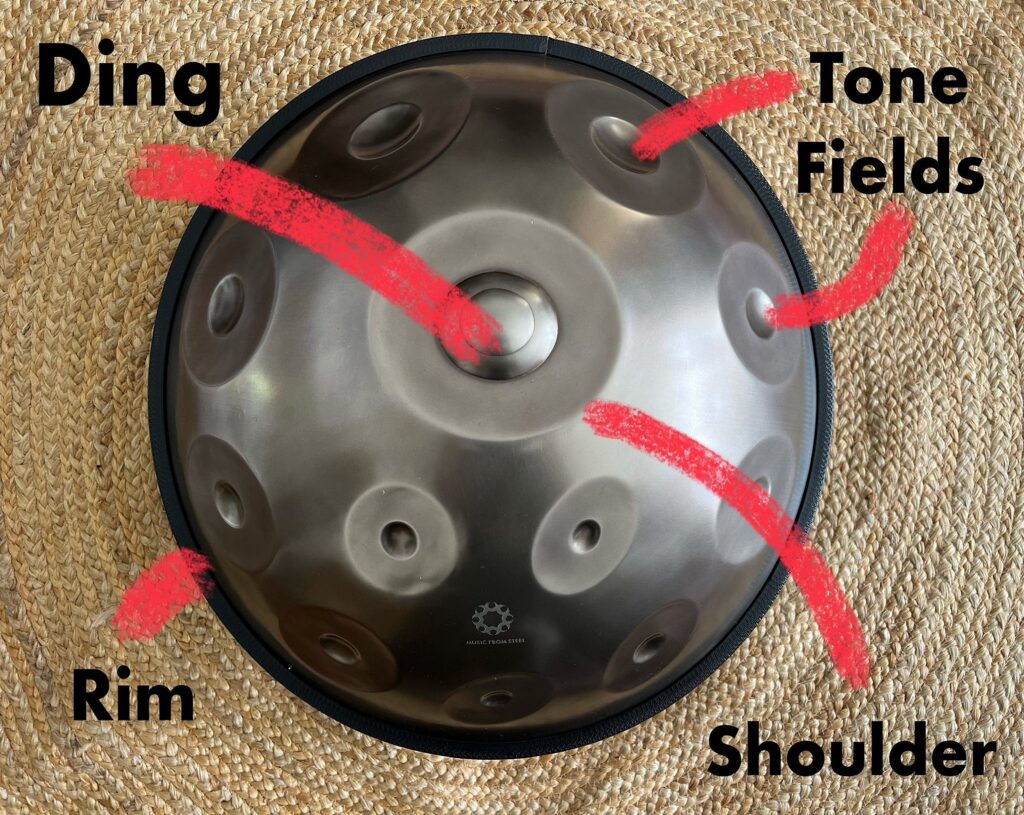About Handpan
All About Handpan
What are the elements of a Handpan?
- Ding: Central low note – tuned to the key of the handpan
- Tone Fields (Notes): arranged around the Ding and each one is tuned to the notes that form the musical scale of the instrument
- Shoulder: The ring around the Ding, produce a percussive sound named “Tak”
- Rim: The outer edge of the handpan
- GU: The resonance hole on the backside of the handpan
- Bottom Notes: Additional notes on the back side of the handpan – Used for extended scales
How are handpans named?

Handpans are named after the “Key” and the “Scale” they are tuned to, so D minor handpan means that it is tune to the key of “D” in a “Minor” scale.
Examples:
Complete d-minor scale:
D, E, F, G, A, Bb, C
“D Kurd 8” scale:
D – A, Bb, C, D, E, F, G, A
“D Celtic 8” scale:
D – A, C, D, E, F, G, A, C
What is a “Key”?
Key is the tuning of the Ding “central note” – and that’s the note the scale starts from.
In Western music, there are 12 different notes alphabetically labeled from A to G
What is a scale?
In music theory, a scale is any set of musical notes ordered by fundamental frequency or pitch. Different orders create different feelings and there are a LOT of different orders.
The 3 main scales widely used on handpans are:
Major scales:
Major scales gives a happy, bright and peaceful sound. Pleasant to play and relaxing, this scale is great for music therapy and meditation. Major scale is constituted of a pattern of whole step and half step.
Minor scales:
Minor scales are complex, sometimes dark and overall more emotional. Having a handpan in a minor scale will allow you to create tension, suspense and a give a sense of mystery to your music. There are 3 types of minor scales, natural minor, harmonic minor and melodic minor each with its own pattern of whole and half steps.
Hijaz scales:
The Hijaz scale is a version of an harmonic minor scale, with its peculiar sound recalling Arabic melodies and atmospheres, can be very suspenseful but also compelling, mysterious, exotic, and even quite sensual like a romantic breeze from the desert sands of timelessness
“Many handpan makers invent their own names for already named scales, thus a jungle of terms has been created, which makes it difficult to understand”
How do Handpan instruments create their special sound?
The sound of the Handpan is generated by the vibration of the different membranes/sound fields that are incorporated on the surface of the tone. The larger the tone field, the deeper the sound, the smaller the tone field, the higher the sound.
The two steel shells glued to each other form a Helmholtz resonance body through the hole in the lower shell (“Gu”), which amplifies the sound of the entire instrument and is largely responsible for the far-reaching and full sound. Usually Handpans are tuned to 440 Hz, which is the contemporary concert pitch. Some instruments are tuned to 432 Hz.Unlike the chromatic steelpan, Handpans are tuned in a specific key. The fundamental, octave and fifth of the fundamental are tuned to each membrane. This peculiarity gives the Handpan its deep and rich sound characteristics.
Caring for Your Handpan: A Guide to Long-lasting Harmony
Owning a handpan is a journey of discovery and delight. To ensure your instrument remains a source of joy for years to come, follow these essential care tips:
1. Gentle Handling: Treat your handpan with care and reverence. Always handle it with clean hands.
2. Regular Cleaning: After each session, wipe your handpan with a soft, dry microfiber cloth to remove dust, moisture, and fingerprints. This simple step helps maintain its pristine appearance and preserves its sound quality.
3. Mindful Storage: Store your handpan in a cool, dry place away from direct sunlight and extreme temperatures. Consider using a hardcase or padded case to shield it from accidental bumps and scratches.
4. Rust Prevention: Handpans are susceptible to rust, especially in humid climates. After playing or cleaning, ensure your handpan is thoroughly dry to prevent moisture buildup. You may also apply a light coat of protective oil or wax to the surface to inhibit rust formation.
5. Cherish the Journey: Finally, remember that your handpan is more than just a musical instrument—it’s a companion on your journey of self-expression and creativity. Treat it with love and gratitude, and it will continue to resonate with the beauty of your soulful melodies.
By following these simple care guidelines, you can ensure that your handpan remains a cherished companion for many years of musical exploration and inspiration.



